Croconic Acid Doped Glycine Single Crystals: Growth, Crystal Structure, UV-Vis, FTIR, Raman and Photoluminescence Spectroscopy
Abstract
1. Introduction
2. Materials and Methods
2.1. Crystal Synthesis
2.2. Experimental Details of Single Crystal XRD
2.3. Experimental Details of Powder XRD
2.4. Raman Scattering, FTIR, UV Vis Absorption, and Photoluminescence
3. Results and Discussion
3.1. Single Crystal XRD Analysis
3.2. Powder XRD Analysis
3.3. Raman and FTIR Spectroscopies
3.4. UV-Vis Absorption
3.5. Photoluminescence
4. Conclusions
Supplementary Materials
Author Contributions
Funding
Institutional Review Board Statement
Informed Consent Statement
Data Availability Statement
Acknowledgments
Conflicts of Interest
References
- Vickery, H.B.; Schmid, C.A. The history of the discovery of the amino acids. Chem. Rev. 1931, 9, 169–318. [Google Scholar] [CrossRef]
- Towler, C.S.; Davey, R.J.; Lancaster, R.W.; Price, C.J. Impact of Molecular Speciation on Crystal Nucleation in Polymorphic Systems: The Conundrum of γ Glycine and Molecular ‘Self Poisoning’. J. Am. Chem. Soc. 2004, 126, 13347–13353. [Google Scholar] [CrossRef]
- Sakai, H.; Hosogai, H.; Kawakita, T. Transformation of α-glycine to γ-glycine. J. Cryst. Growth 1992, 116, 421–426. [Google Scholar] [CrossRef]
- Tylczyński, Z.; Busz, P. Transformation from γ to α modification in glycine crystal. Ph. Transit. 2014, 87, 1157–1164. [Google Scholar] [CrossRef]
- Dawson, A.; Allan, D.R.; Belmonte, S.A.; Clark, S.J.; David, W.I.F.; McGregor, P.A.; Parsons, S.; Pulham, C.R.; Sawyer, L. Effect of High Pressure on the Crystal Structures of Polymorphs of Glycine. Cryst. Growth Des. 2005, 5, 1415–1427. [Google Scholar] [CrossRef]
- Losev, E.A.; Mikhailenko, M.A.; Achkasov, A.F.; Boldyreva, E.V. The effect of carboxylic acids on glycine polymorphism, salt and co-crystal formation. A comparison of different crystallisation techniques. New J. Chem. 2013, 37, 1973–1981. [Google Scholar] [CrossRef]
- Fleck, M.; Petrosyan, A.M. Salts of Amino Acids. Crystallization, Structure and Properties; Springer International Publication: Cham, Switzerland, 2014. [Google Scholar]
- Flores, M.Z.S.; Freire, V.N.; dos Santos, R.P.; Farias, G.A. Optical absorption and electronic band structure first-principles calculations of α-glycine crystals. Phys. Rev. B 2008, 77, 115104. [Google Scholar] [CrossRef]
- Peter, M.E.; Ramasamy, P. Growth of gamma glycine crystal and its characterization. Spectrochim. Acta A 2010, 75, 1417–1421. [Google Scholar] [CrossRef]
- Ahamed, Z.A.S.; Dillip, G.R.; Raghavaiah, P.; Mallikarjuna, K.; Raju, B.D.P. Spectroscopic and thermal studies of γ-glycine crystal grown from potassium bromide for optoelectronic applications. Arab. J. Chem. 2013, 6, 429–433. [Google Scholar] [CrossRef]
- Dillip, G.R.; Raghavaiah, P.; Mallikarjuna, K.; Reddy, C.M.; Bhagavannarayana, G.; Kumar, V.R.; Raju, B.D.P. Crystal growth and characterization of γ-glycine grown from potassium fluoride for photonic applications. Spectrochim. Acta A 2011, 79, 1123–1127. [Google Scholar] [CrossRef]
- Rodríguez, J.S.; Costa, G.; da Silva, M.B.; Silva, B.P.; Honório, L.J.; de Lima-Neto, P.; Santos, R.C.R.; Caetano, E.W.S.; Alves, H.W.L.; Freire, V.N. Structural and Optoelectronic Properties of the α-, β-, and γ-Glycine Polymorphs and the Glycine Dihydrate Crystal: A DFT Study. Cryst. Growth Des. 2019, 19, 5204. [Google Scholar] [CrossRef]
- Kumar, R.A.; Vizhi, R.E.; Vijayan, N.; Babu, D.R. Structural, dielectric and piezoelectric properties of nonlinear optical γ-glycine single crystals. Phys. B 2011, 406, 2594–2600. [Google Scholar] [CrossRef]
- Justin, P.; Anitha, K. Influence of formic acid on optical and electrical properties of glycine crystal. Mater. Res. Express 2017, 4, 115101. [Google Scholar] [CrossRef]
- Tylczyński, Z.; Busz, P. Low-temperature phase transition in γ-glycine single crystal. Pyroelectric, piezoelectric, dielectric and elastic properties. Mater. Chem. Phys. 2016, 183, 254–262. [Google Scholar] [CrossRef]
- Guerin, S.; Stapleton, A.; Chovan, D.; Mouras, R.; Gleeson, M.; McKeown, C.; Noor, M.R.; Silien, C.; Rhen, F.M.F.; Kholkin, A.L.; et al. Control of piezoelectricity in amino acids by supramolecular packing. Nat. Mater. 2018, 17, 180–186. [Google Scholar] [CrossRef] [PubMed]
- Lemanov, V.V. Piezoelectric and pyroelectric properties of protein amino acids as basic materials of Soft State Physics. Ferroelectrics 2000, 238, 211–218. [Google Scholar] [CrossRef]
- Okosun, F.; Guerin, S.; Celikin, M.; Pakrashi, V. Flexible amino acid-based energy harvesting for structural health monitoring of water pipes. Cell Rep. Phys. Sci. 2021, 2, 100434. [Google Scholar] [CrossRef]
- Vijayalakshmia, V.; Dhanasekaran, P. Growth and characterization study of γ-glycine crystal grown using different mole concentrations of zinc sulphate as structure-directing agents. J. Cryst. Growth 2018, 498, 372–376. [Google Scholar] [CrossRef]
- Han, G.; Chow, P.S.; Tan, R.B.H. Understanding the Salt-Dependent Outcome of Glycine Polymorphic Nucleation. Pharmaceutics 2021, 13, 262. [Google Scholar] [CrossRef]
- Li, D.; Zong, S.; Dang, L.; Wang, Z.; Wei, H. Effects of inorganic additives on polymorphs of glycine in microdroplets. CrystEngComm 2018, 20, 164–172. [Google Scholar] [CrossRef]
- Bhat, M.N.; Dharmaprakash, S.M. Effect of solvents on the growth morphology and physical characteristics of nonlinear optical g-glycine crystals. J. Cryst. Growth 2002, 242, 245–252. [Google Scholar] [CrossRef]
- Balakrishnan, T.; Babu, R.R.; Ramamurthi, K. Growth, structural, optical and thermal properties of γ-glycine crystal. Spectrochim. Acta Part A Mol. Biomol. Spectrosc. 2008, 69, 1114–1118. [Google Scholar] [CrossRef] [PubMed]
- Dhanaraj, P.V.; Rajesh, N.P. Growth and characterization of nonlinear optical γ-glycine single crystal from lithium acetate as solvent. Mater. Chem. Phys. 2009, 115, 413–417. [Google Scholar] [CrossRef]
- Azhagan, S.A.C.; Ganesan, S. Crystal growth, structural, optical, thermal and NLO studies of γ-glycine single crystals. Optik 2013, 124, 6456–6460. [Google Scholar] [CrossRef]
- Anis, M.; Ramteke, S.P.; Shirsat, M.D.; Muley, G.G.; Baig, M.I. Novel report on g-glycine crystal yielding high second harmonic generation efficiency. Opt. Mater. 2017, 72, 590–595. [Google Scholar] [CrossRef]
- Whatmore, R.W. Pyroelectric devices and materials. Rep. Prog. Phys. 1986, 49, 1335–1386. [Google Scholar] [CrossRef]
- Szafran, M.; Tylczyński, Z.; Wiesner, M.; Czarnecki, P.; Ghazaryan, V.V.; Petrosyan, A.M. Above-room-temperature ferroelectricity and piezoelectric activity of dimethylglycinium-dimethylglycine chloride. Mater. Des. 2022, 220, 110893. [Google Scholar] [CrossRef]
- Balashova, E.V.; Lemanov, V.V. Dielectric and Acoustic Properties of Some Betaine and Glycine Compounds. Ferroelectrics 2003, 285, 179–205. [Google Scholar] [CrossRef]
- Horiuchi, S.; Tokunaga, Y.; Giovannetti, G.; Picozzi, S.; Itoh, H.; Shimano, R.; Kumai, R.; Tokura, Y. Above-room-temperature ferroelectricity in a single-component molecular crystal. Nature 2010, 463, 789–792. [Google Scholar] [CrossRef]
- Balashova, E.; Levin, A.A.; Davydov, V.; Smirnov, A.; Starukhin, A.; Pavlov, S.; Krichevtsov, B.; Zolotarev, A.; Zhang, H.; Li, F.; et al. Croconic Acid Doped Triglycine Sulfate: Crystal Structure, UV-Vis, FTIR, Raman, Photoluminescence Spectroscopy, and Dielectric Properties. Crystals 2022, 12, 679. [Google Scholar] [CrossRef]
- Balashova, E.V.; Smirnov, A.N.; Davydov, V.Y.; Krichevtsov, B.B.; Starukhin, A.N. Raman scattering and luminescence in single crystals of the amino acid glycine C2H5NO2 with an admixture of croconic acid C5H2O5. J. Phys. Conf. Ser. 2021, 2103, 012070. [Google Scholar] [CrossRef]
- Braga, D.; Maini, L.; Grepioni, F. Crystallization from hydrochloric acid affords the solid-state structure of croconic acid (175 years after its discovery) and a novel hydrogen-bonded network. CrystEngComm. 2001, 3, 27. [Google Scholar] [CrossRef]
- Sheldrick, G.M. A short history of SHELX. Acta Crystallogr. A 2008, 64, 112–122. [Google Scholar] [CrossRef]
- Dolomanov, O.V.; Bourhis, L.J.; Gildea, R.J.; Howard, J.A.K.; Puschmann, H. OLEX2: A complete structure solution, refinement and analysis program. J. Appl. Crystallogr. 2009, 42, 339–341. [Google Scholar] [CrossRef]
- Momma, K.; Izumi, F. VESTA 3 for three-dimensional visualization of crystal, volumetric and morphology data. J. Appl. Crystallogr. 2011, 44, 1272–1276. [Google Scholar] [CrossRef]
- Maunders, C.; Etheridge, J.; Wright, N.; Whitfield, H.J. Structure and microstructure of hexagonal Ba3Ti2RuO9 by electron diffraction and microscopy. Acta Crystallogr. B 2005, 61, 154–159. [Google Scholar] [CrossRef]
- Terlan, B.; Levin, A.A.; Börrnert, F.; Simon, F.; Oschatz, M.; Schmidt, M.; Cardoso-Gil, R.; Lorenz, T.; Baburin, I.A.; Joswig, J.-O.; et al. Effect of Surface Properties on the Microstructure, Thermal, and Colloidal Stability of VB2 Nanoparticles. Chem. Mater. 2015, 27, 5106–5115. [Google Scholar] [CrossRef]
- Terlan, B.; Levin, A.A.; Börrnert, F.; Zeisner, J.; Kataev, V.; Schmidt, M.; Eychmüller, A. A Size-Dependent Analysis of the Structural, Surface, Colloidal, and Thermal Properties of Ti1–xB2 (x = 0.03–0.08) Nanoparticles. Eur. J. Inorg. Chem. 2016, 6, 3460–3468. [Google Scholar] [CrossRef]
- Levin, A.A. Program SizeCr for Calculation of the Microstructure parameters from X-ray Diffraction Data. Preprint. 2022. Available online: https://www.researchgate.net/profile/Alexander-Levin-6/publication/359402043 (accessed on 5 June 2022). [CrossRef]
- Balashova, E.; Levin, A.A.; Fokin, A.; Redkov, A.; Krichevtsov, B. Structural Properties and Dielectric Hysteresis of Molecular Organic Ferroelectric Grown from Different Solvents. Crystals 2021, 11, 1278. [Google Scholar] [CrossRef]
- Brucker AXS GmbH. TOPAS; Version 5, Technical reference; Bruker AXS GmbH: Karlsruhe, Germany, 2014. [Google Scholar]
- le Bail, A.; Duroy, H.; Fourquet, J.L. Ab-initio structure determination of LiSbWO6 by X-ray powder diffraction. Mater. Res. Bull. 1988, 23, 447–452. [Google Scholar] [CrossRef]
- Rietveld, H.M. Line profiles of neutron powder-diffraction peaks for structure Refinement. Acta Crystallogr. 1967, 22, 151–152. [Google Scholar] [CrossRef]
- Dollase, W.A. Correction of Intensities for Preferred Orientation in Powder Diffractometry: Application of the March Model. J. Appl. Crystallogr. 1986, 19, 267–272. [Google Scholar] [CrossRef]
- Järvinen, M. Application of symmetrized harmonics expansion to correction of the preferred orientation effect. J. Appl. Cryst. 1993, 26, 525–531. [Google Scholar] [CrossRef]
- Bérar, J.-F.; Lelann, P.J. E.s.d.’s and Estimated Probable Error Obtained in Rietveld Refinements with Local Correlations. J. Appl. Crystallogr. 1991, 24, 1–5. [Google Scholar] [CrossRef]
- Levin, A.A. Program RietESD for Correction of Estimated Standard Deviations Obtained in Rietveld-Refinement Program. Preprint. 2022. Available online: https://www.researchgate.net/profile/Alexander-Levin-6/publication/359342753 (accessed on 5 June 2022). [CrossRef]
- Andreev, Y.G. The Use of the Serial-Correlations Concept in the Figure-of-Merit Function for Powder Diffraction Profile Fitting. J. Appl. Crystallogr. 1994, 27, 288–297. [Google Scholar] [CrossRef]
- Balashova, E.V.; Svinarev, F.B.; Zolotarev, A.A.; Levin, A.A.; Brunkov, P.N.; Davydov, V.Y.; Smirnov, A.N.; Redkov, A.V.; Pankova, G.A.; Krichevtsov, B.B. Crystal structure, Raman spectroscopy and dielectric properties of new semi-organic crystals based on 2-methylbenzimidazole. Crystals 2019, 9, 573. [Google Scholar] [CrossRef]
- Farrugia, L.J. ORTEP-3 for Windows - a version of ORTEP-III with a Graphical User Interface (GUI). J. Appl. Crystallogr. 1997, 30, 565. [Google Scholar] [CrossRef]
- Langan, P.; Mason, S.A.; Myles, D.; Schoenborn, B.P. Structural characterization of crystals of α-glycine during anomalous electrical behaviour. Acta Crystallogr. B 2002, B58, 728–733. [Google Scholar] [CrossRef]
- Boldyreva, E.V.; Drebushchak, T.N.; Shutova, E.S. Structural distortion of the a, b, and g polymorphs of glycine on cooling. Z. Kristallogr. Cryst. Mater. 2003, 218, 366–376. [Google Scholar] [CrossRef]
- Aree, T.; Bürgi, H.-B.; Chernyshov, D.; Törnroos, K.W. Dynamics and Thermodynamics of Crystalline Polymorphs. 3. γ-Glycine, Analysis of Variable Temperature Atomic Displacement Parameters, and Comparison of Polymorph Stabilities. J. Phys. Chem. A 2014, 118, 9951–9959. [Google Scholar] [CrossRef]
- Hill, R.J.; Fischer, R.X. Profile agreement indices in Rietveld and pattern-fitting analysis. J. Appl. Crystallogr. 1990, 23, 462–468. [Google Scholar] [CrossRef]
- Surovtsev, N.V.; Malinovsky, V.K.; Boldyreva, E.V. Raman study of low-frequency modes in three glycine polymorphs. J. Chem. Phys. 2011, 134, 045102. [Google Scholar] [CrossRef] [PubMed]
- Andrews, B.; Torrie, B.H.; Powell, B.M. Intermolecular potentials for alpha-glycine from Raman and infrared scattering measurements. Biophys. J. 1983, 41, 293–298. [Google Scholar] [CrossRef]
- Baran, J.; Ratajczak, H. Polarised IR and Raman spectra of the γ-glycine single crystal. Spectrochim. Acta A 2005, 61, 1611–1626. [Google Scholar] [CrossRef]
- Colmenero, F.; Escribano, R. Thermodynamic, Raman Spectroscopic, and UV–Visible Optical Characterization of the Deltic, Squaric, and Croconic Cyclic Oxocarbon Acids. J. Phys. Chem. A 2019, 123, 4241–4261. [Google Scholar] [CrossRef] [PubMed]
- Yamada, K.; Mizuno, N.; Hirata, Y. Structure of Croconic Acid. Bull. Chem. Soc. Jap. 1958, 31, 543–549. [Google Scholar] [CrossRef]
- Feng, S.; Yang, H.; Jiang, X.; Wang, Y.; Zhu, M. A New 3D Silver(I) Coordination Polymer with Croconate Ligand Displaying Green Luminescent. J. Mol. Struct. 2015, 1081, 1–5. [Google Scholar] [CrossRef]

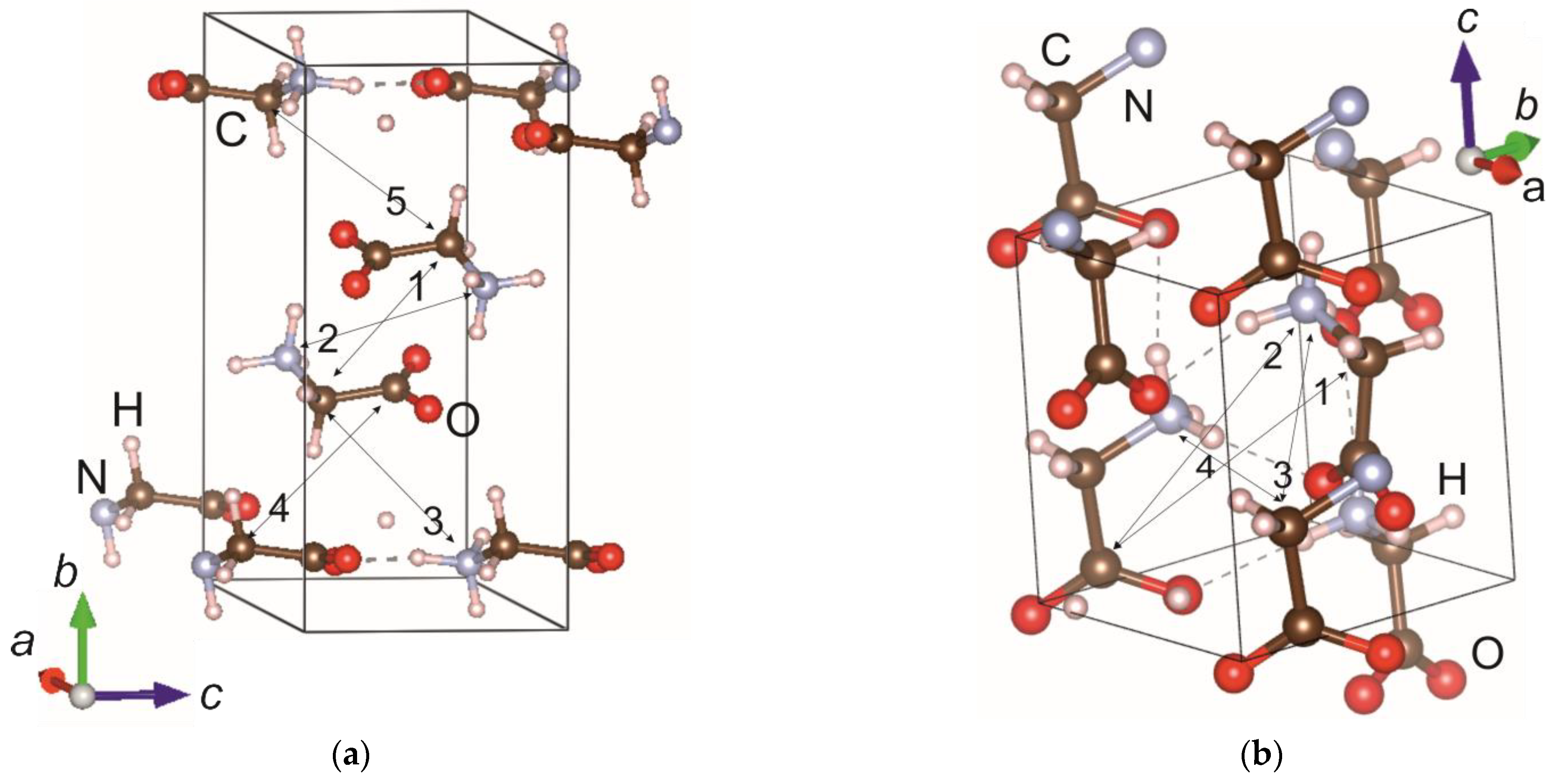
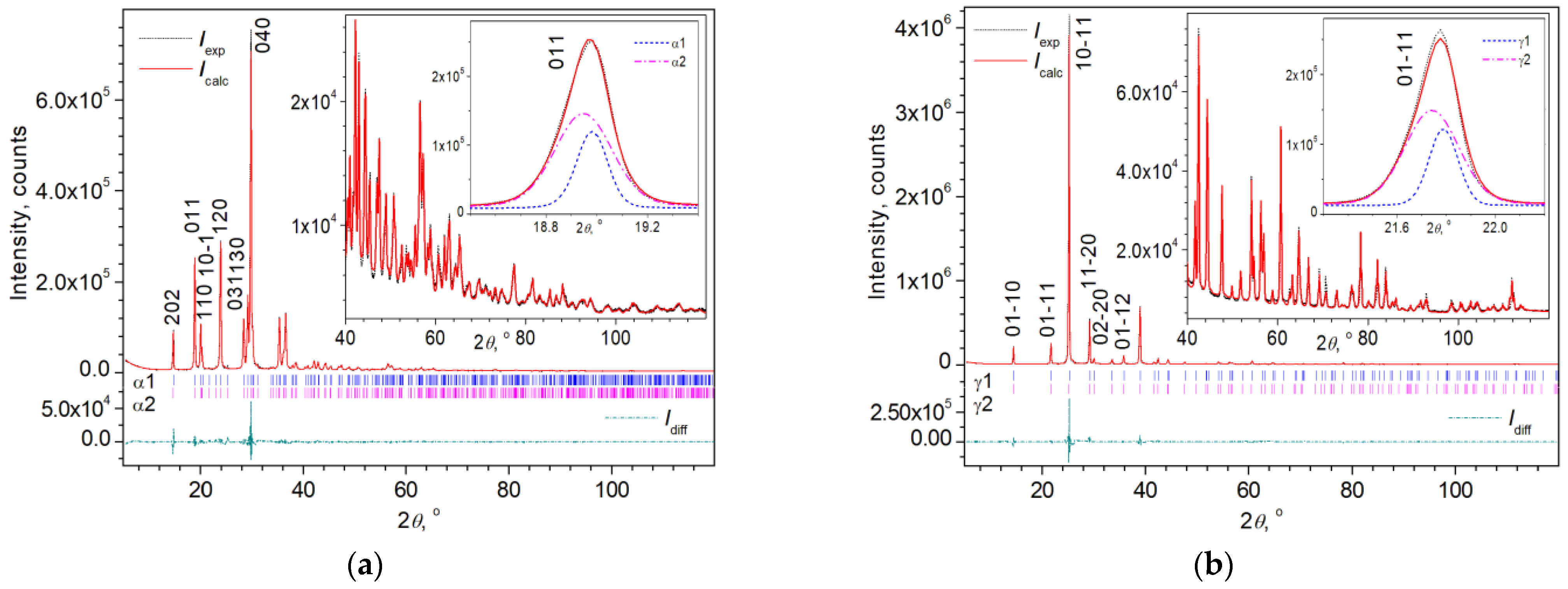
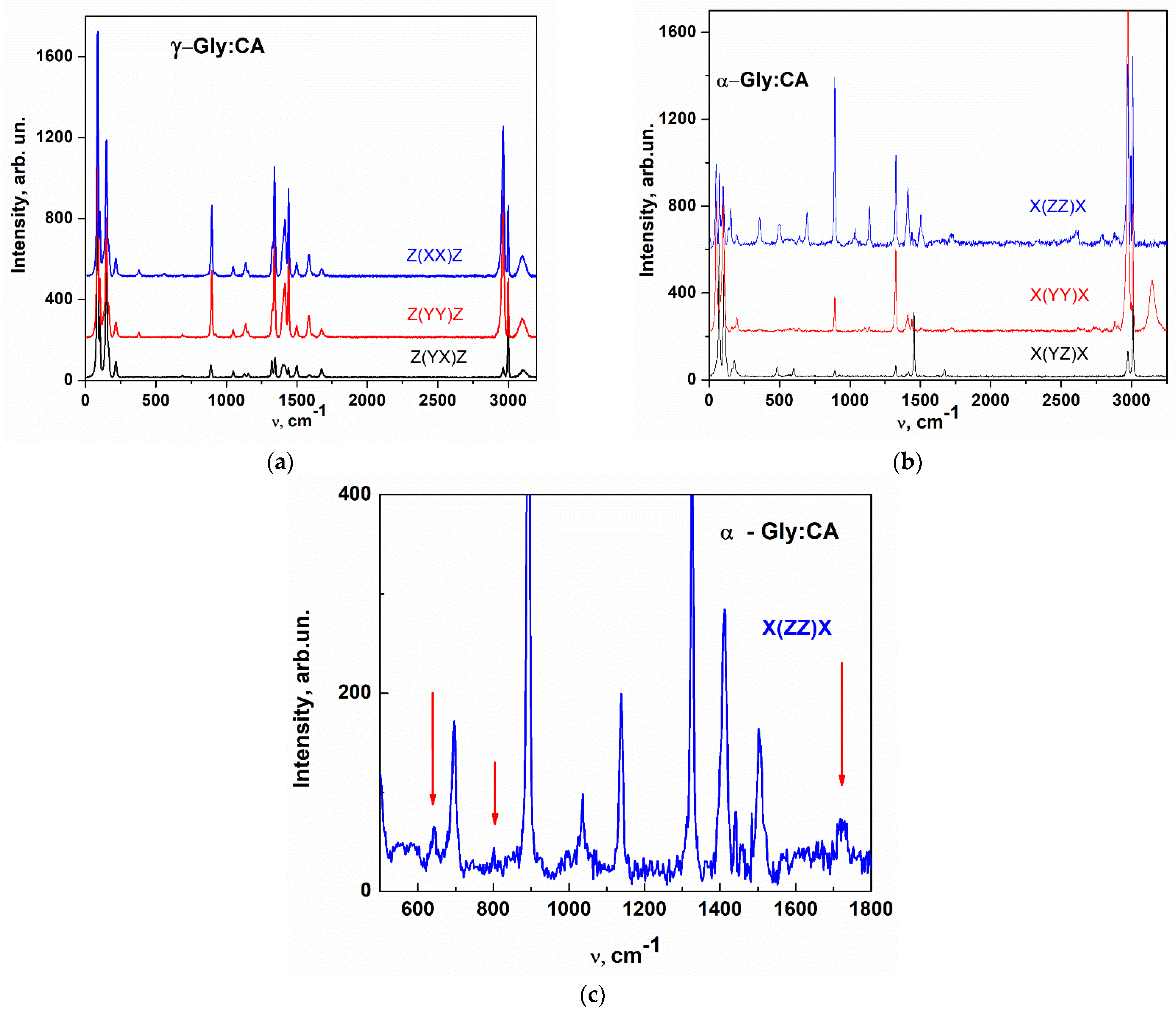
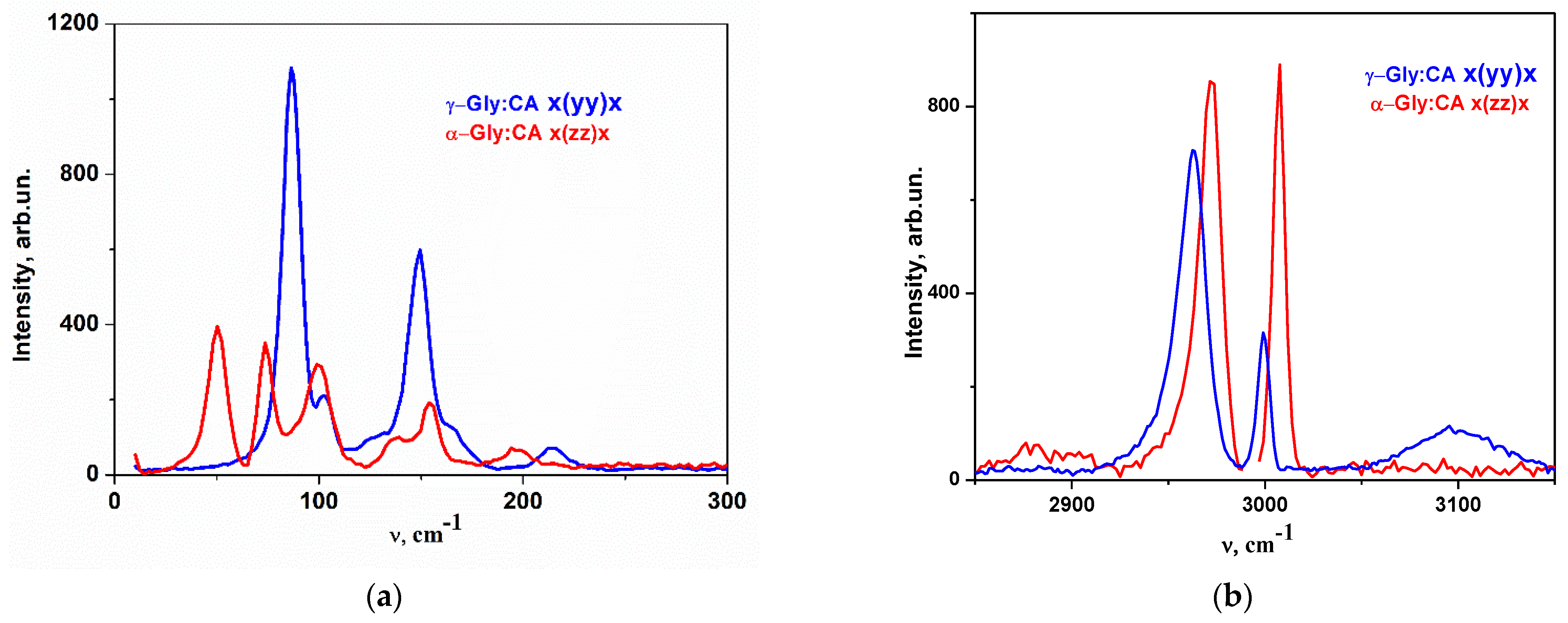
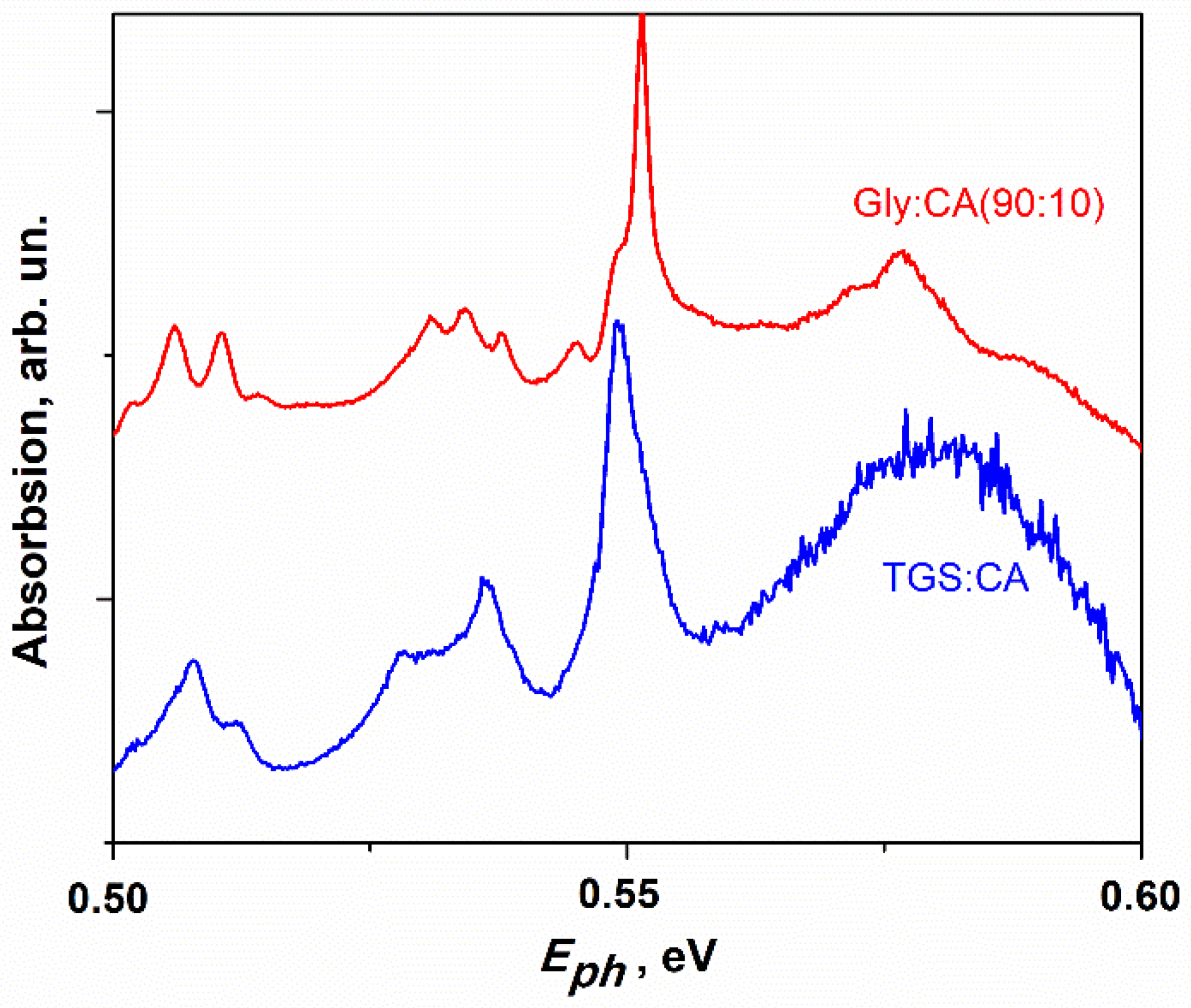
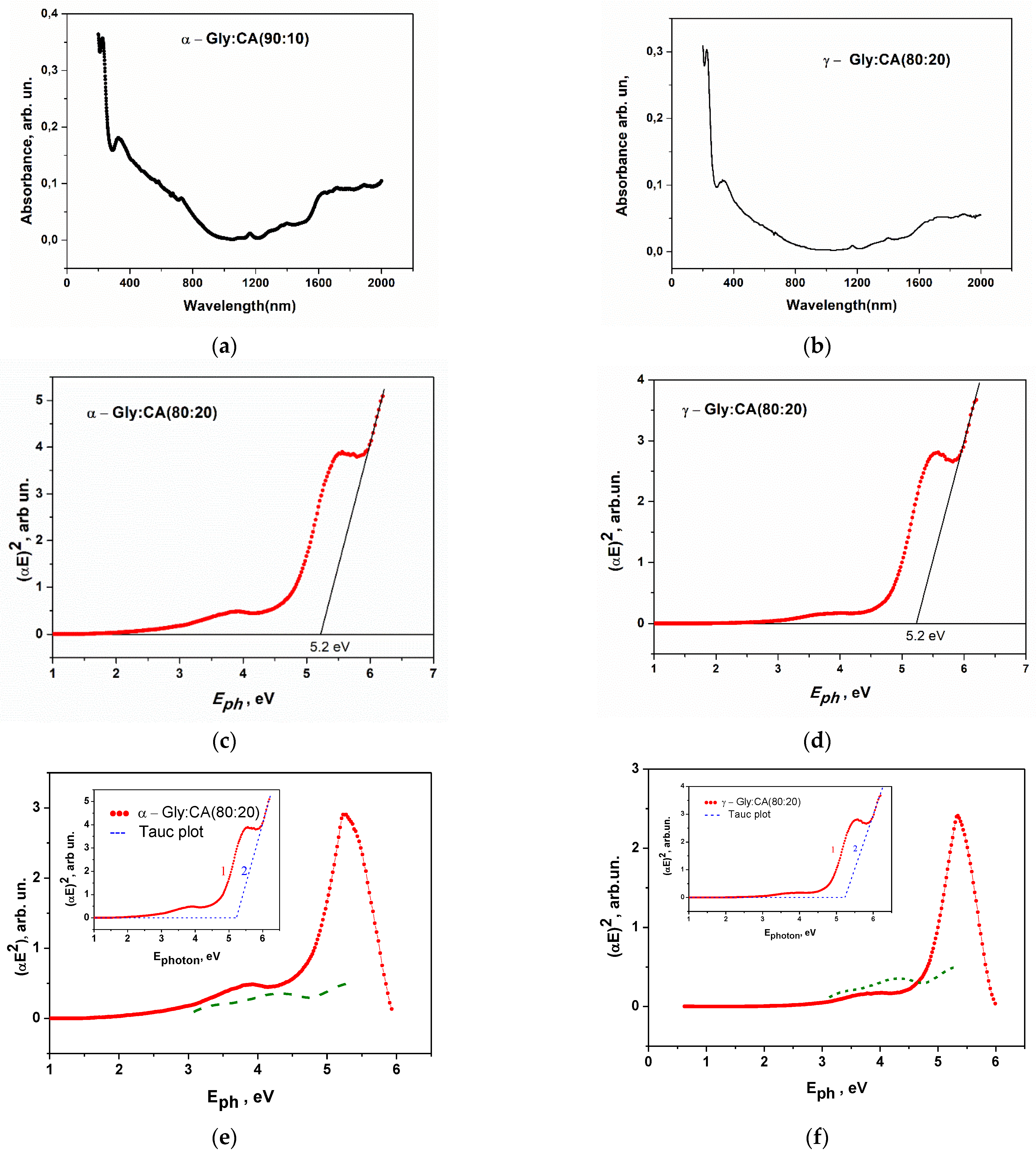
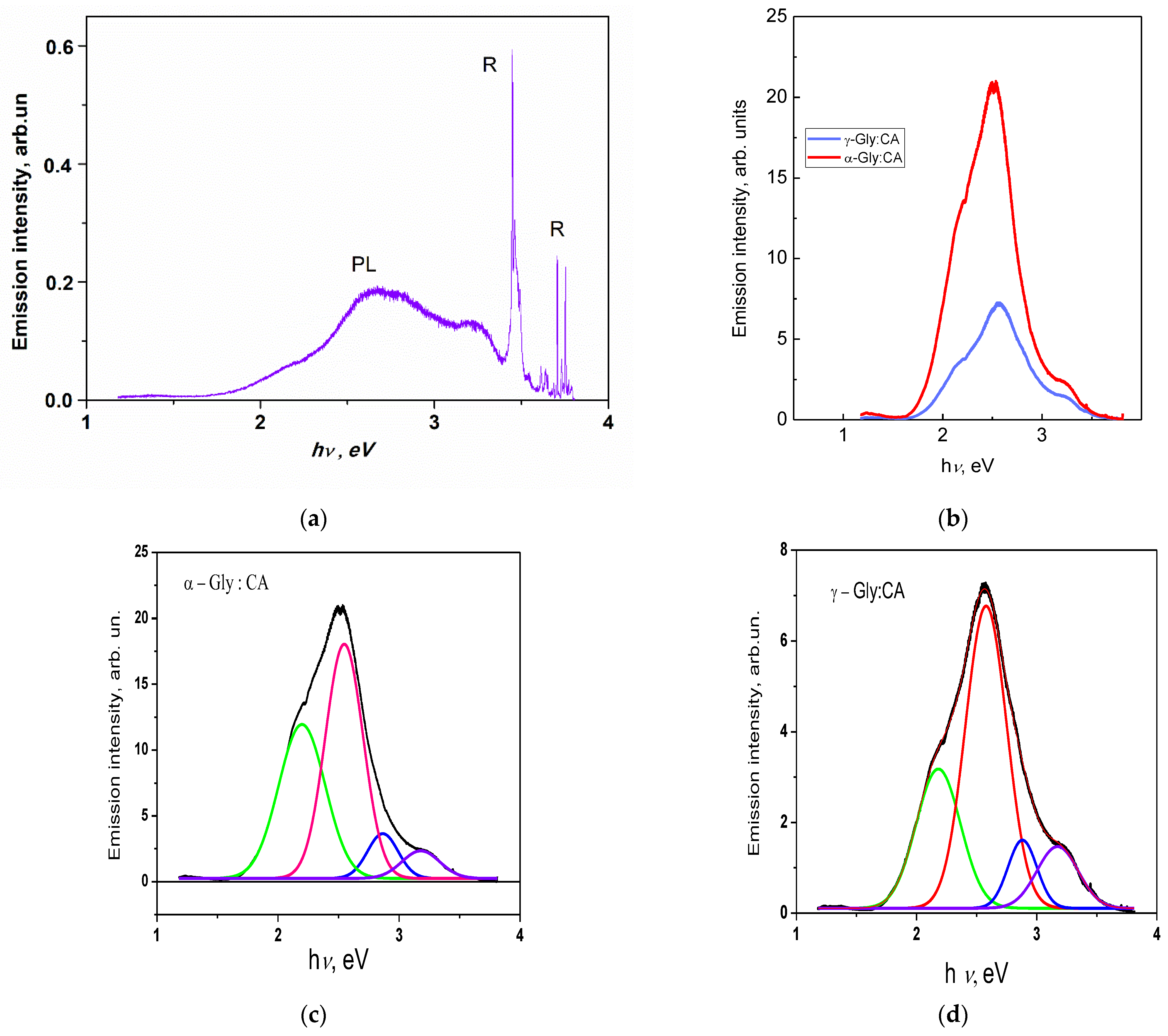
| α-Gly:CA (90:10) | γ-Gly:CA (80:20) | |
|---|---|---|
| Chemical formula | C2H5NO2 | C2H5NO2 |
| Formula weight, Da | 75.07 | 75.07 |
| Space group | P21/n (14) | P31 (144) |
| a, Å | 5.1004 (5) | 6.9848 (3) |
| b, Å | 11.9664 (9) | 6.9848 (3) |
| c, Å | 5.4570 (5) | 5.4744 (2) |
| β, ° | 111.714 (3) | 90 |
| Vcell, Å3 | 309.43 (5) | 231.30 (2) |
| Z | 4 | 3 |
| Dcalc, g∙cm−3 | 1.611 | 1.617 |
| F (000) | 160.0 | 120.0 |
| μ, mm−1 | 0.143 | 1.25 |
| Radiation (λ, Å) | Mo-Kα (0.71073) | Cu-Kα (1.54184) |
| Θ max, ° | 26.35 | 77.18 |
| h, k, l max | 6, 14, 6 | 8, 8, 6 |
| Reflections collected | 3240 | 3120 |
| Independent reflections | 629 | 645 |
| Data/restraints/parameters | 629/0/47 | 645/1/48 |
| GOOF | 1.158 | 1.081 |
| Final R indexes [Reflections I ≥ 2σ (I)] | R1 = 0.0345, wR2 = 0.1109 [629] | R1 = 0.0299, wR2 = 0.0735 [645] |
| Final R indexes [Reflections all] | R1 = 0.0416, wR2 = 0.1173 [538] | R1 = 0.0299, wR2 = 0.0735 [645] |
| Largest difference peak/hole, e∙Å−3 | 0.19/−0.19 | 0.16/−0.20 |
| Temperature of measurements, K | 298 | 100 |
| α-Gly:CA (90:10) 298 K | α-Gly [53] 294 K | α-Gly [52] 301 K | |
|---|---|---|---|
| a, Å | 5.1004 (5) | 5.1047 (3) | 5.0999 (3) |
| b, Å | 11.9664 (9) | 11.9720 (14) | 11.9516 (6) |
| c, Å | 5.4570 (5) | 5.4631 (3) | 5.4594 (3) |
| β, ° | 111.714 (3) | 111.740 (5) | 111.781 (2) |
| Vcell, Å3 | 309.43 (5) | 310.10 (4) | 309.00 (3) |
| γ-Gly:CA (80:20) 100 K | γ-Gly [53] 150 K | γ-Gly [54] 100 K | γ-Gly [53] 294 K | γ-Gly [54] 300 K | |
|---|---|---|---|---|---|
| a, Å | 6.9848 (3) | 6.998 (16) | 6.9869 (1) | 7.0383 (7) | 7.0402 (1) |
| c, Å | 5.4744 (2) | 5.4784 (18) | 5.4768 (1) | 5.4813 (8) | 5.4813 (1) |
| Vcell, Å3 | 231.30 (2) | 232.5 (1) | 231.540 (6) | 235.15 (3) | 235.280 (6) |
| α-Gly:CA (90:10) | α-Gly [53] | α-Gly [52] | |
|---|---|---|---|
| bond angles, ° | |||
| O1–C1–O2 | 125.86 (15) | 125.62 (7) | 125.45 (7) |
| C2–C1–O1 | 116.69 (15) | 116.93 (7) | 117.16 (7) |
| C2–C1–O2 | 117.44 (14) | 117.44 (6) | 117.38 (6) |
| C1–C2–N1 | 111.78 (13) | 111.70 (6) | 111.83 (5) |
| bond lengths, Å | |||
| C1–O1 | 1.251 (2) | 1.2549 (9) | 1.2512 (10) |
| C1–O2 | 1.247 (2) | 1.2517 (9) | 1.2480 (10) |
| C2–N1 | 1.475 (2) | 1.4777 (10) | 1.4743 (8) |
| C1–C2 | 1.526 (2) | 1.5268 (9) | 1.5252 (9) |
| γ-Gly:CA (80:20) 100K | γ-Gly [53] 150 K | γ-Gly [54] 100 K | |
|---|---|---|---|
| bond angles, ° | |||
| O1–C1–O2 | 126.0 (3) | 125.3 (2) | 125.70 (7) |
| C2–C1–O1 | 116.4 (2) | 116.8 (2) | 116.61 (7) |
| C2–C1–O2 | 117.6 (3) | 117.8 (2) | 117.63 (6) |
| C1–C2–N1 | 111.6 (2) | 111.2 (2) | 111.55 (6) |
| bond lengths, Å | |||
| C1–O1 | 1.260 (4) | 1.263 (3) | 1.2572 (9) |
| C1–O2 | 1.248 (4) | 1.251 (3) | 1.2487 (9) |
| C2–N1 | 1.479 (4) | 1.480 (3) | 1.4719 (10) |
| C1–C2 | 1.524 (4) | 1.529 (3) | 1.5249 (9) |
| a, Å b, Å | c, Å β, ° | Vcell, Å | D (nm) εs, % |
|---|---|---|---|
| α-Gly:CA (90:10), LPA | |||
| phase α1 | |||
| 5.1050 (16) a 11.9771 (40) a | 5.4614 (17) a 111.74 (2) a | 310.18 (18) | 52 (9)/78 (14) b 0.07 (6)/0.16 (4) b |
| phase α2 | |||
| 5.1216 (20) a 12.0064 (64) a | 5.4715 (22) a 111.70 (3) a | 312.61 (25) | 44 (3)/54 (3) b 0.06 (4)/0.14 (2) b |
| α-Gly:CA (90:10), LB fitting | |||
| phase α1 | |||
| 5.1002 (10) c 11.9709 (6) c | 5.4613 (10) c 111.68 (2) c | 309.85 (9) | 96 (4) c,d 0.050 (6) c,d |
| phase α2 | |||
| 5.1107 (5) c 12.0102 (8) d | 5.4694 (6) c 111.70 (1) c | 311.31 (5) | 37.4 (2) c,d 0.11 (2) c,d |
| α-Gly:CA (90:10), Rietveld fitting (without refinement of atomic coordinates) | |||
| phase α1 | |||
| 5.1000 (16) c 11.9704 (8) c | 5.4613 (9) c 111.71 (2) c | 399.76 (12) | 98 (5) c,d 0.050 (6) c,d |
| phase α2 | |||
| 5.1107 (5) c 12.0102 (8) d | 5.4694 (6) c 111.70 (1) c | 311.31 (5) | 38.4 (6) c,d 0.11 (1) c, d |
| α-Gly:CA (90:10), Rietveld fitting (with refinement of atomic coordinates) | |||
| phase α1 | |||
| 5.0999 (10) c 11.9701 (7) c | 5.4613 (10) c 111.71 (2) c | 309.74 (10) | 98 (5) c,d 0.050 (6) c,d |
| phase α2 | |||
| 5.1109 (7) c 12.0102 (10) d | 5.4684 (7) c 111.69 (2) c | 311.90 (8) | 38.9 (5) c,d 0.12 (1) c,d |
| γ-Gly:CA (80:20), LPA | |||
| phase γ1 | |||
| 7.0388 (6) a a | 5.4797 (9) a 90 | 235.12 (4) | 70 (12)/82 (7) b 0/0.057 (16) b |
| phase γ2 | |||
| 7.0541 (14) a a | 5.4890 (18) a 90 | 236.54 (9) | 48 (8)/48 (8) b 0/0b |
| γ-Gly:CA (80:20), LB fitting | |||
| phase γ1 | |||
| 7.0404 (4) c a | 5.4838 (28) c 90 | 235.40 (12) | 92 (3) c,d 0.044 (16) c,d |
| phase γ2 | |||
| 7.0600 (7) c a | 5.4903 (21) c 90 | 236.99 (10) | 35.7 (7) c,d 0c |
| γ-Gly:CA (80:20), Rietveld fitting (without refinement of atomic coordinates) | |||
| phase γ1 | |||
| 7.0402 (5) c a | 5.4817 (35) c 90 | 235.30 (15) | 92 (4) c,d 0.051 (17) c,d |
| phase γ2 | |||
| 7.0602 (9) c a | 5.4903 (9) c 90 | 237.01 (5) | 35.7 (9) c,d 0 c |
| Rwp, % Rp, % | cRwp, % a cRp, % a | RB, % p1 RB, % p2 | Wt, wt.% p1 Wt, wt.% p2 | me.s.d.a |
|---|---|---|---|---|
| α-Gly:CA (90:10), LB fitting | ||||
| 4.82 3.09 | 7.04 5.24 | - - | - - | 5.05 |
| α-Gly:CA (90:10), Rietveld fitting (without refinement of atomic coordinates) | ||||
| 6.35 4.17 | 9.42 7.36 | 0.98 1.13 | 24.4 (1) b 75.6 (1) b | 5.24 |
| α-Gly:CA (90:10), Rietveld fitting (with refinement of atomic coordinates) | ||||
| 5.77 3.87 | 8.54 6.82 | 0.71 0.58 | 23.4 (1) b 76.6 (1) b | 5.33 |
| γ- Gly:CA (80:20), LB fitting | ||||
| 9.96 6.21 | 13.14 9.58 | - - | - - | 6.97 |
| γ-Gly:CA (80:20), Rietveld fitting (without refinement of atomic coordinates) | ||||
| 11.36 7.40 | 14.97 11.31 | 1.94 2.92 | 33.2 (5) b 66.8 (5) b | 7.09 |
| Raman (ν, cm−1) | FTIR (ν, cm−1) | Assignments [57] | ||
|---|---|---|---|---|
| X(zz)X | X(yy)X | X(yz)X | ||
| - | 3095.4 m | - | 3100 m | νNH (3)···O (1) |
| - | 2999.1 s | 2999.1 s | - | νaCH2 |
| 2963.7 s | 2962.6 vs | 2964.8 m | 2963 w | νsCH2 |
| 2849.6 w | - | - | - | - |
| 2744.5 vw | - | - | - | νNH (1)···O (1) |
| 2695.7 vw | - | - | - | νNH (1)···O (1) |
| 2611.6 w | - | - | - | νNH (1)···O (1) |
| - | - | - | 1736 w | - |
| - | 1676.1 w | - | 1684m | - |
| 1659.5 w | - | - | 1665 w | δaNH3+ |
| - | - | - | 1630 s | δaNH3+ |
| - | - | - | 1601 vs | νaCOO− |
| - | - | 1589.8 w | - | - |
| - | 1576.5 m | - | - | νaCOO− (?) |
| - | - | - | 1557 m | - |
| - | 1506.7 m | - | 1506 m | - |
| - | - | 1502.3 vw | 1499 s | δsNH3+ |
| 1483.5 vw | - | - | - | δsNH3+ |
| 1438.1 w | 1437 s | 1440.3 m | 1439 w | δCH2 |
| 1389.4 vw | 1393.8 s | - | 1398 m | νsCOO− |
| - | 1335.2 s | - | 1344 m | ωCH2 |
| - | - | 1321.9 m | 1321 w | τCH2 |
| - | 1154.7 w | 1156.9 vw | 1153 m | ρNH3+ |
| - | 1135.9 m | 1130.3 w | - | ρNH3+ |
| - | - | - | 1126 s | ρNH3+ |
| - | 1047.3 w | 1048.4 m | 1049 vw | νaCCN |
| 924.47 sh | 931.11 w | 931.6 s | ρCH2 | |
| 892.37 s | 892.37 s | 892.37 w | 889.2 m | νCC |
| 749.55 vw | - | - | - | - |
| 683.13 m | 688.67 vw | 687.56 w | 692.4 m | σCOO− |
| - | - | ̶ | 667.37 m | - |
| 607.85 w | - | 607.85 w | - | - |
| 560.24 vw | - | 558.03 w | - | - |
| - | - | 517.07 w | - | ωCOO− |
| 502.68 s | - | - | - | τCOO− |
| - | - | 500.46 m | - | ρCOO− |
| 354.33 m | 354.33 w | 359.86 w | - | ρCCN |
| - | 213.,73 m | 215.94 w | - | - |
| - | 171.66 sh | - | ω or τ CCN | |
| 174.98 w | - | - | - | Lattice modes |
| - | 165.02 sh | - | - | -“- |
| - | 149.52 s | - | - | -“- |
| - | - | 138.45 s | - | -“- |
| - | 127.38 sh | - | - | -“- |
| 108.56 vw | 101.92 m | 103.02 m | - | -“- |
| 90.9 vw | 86.42 vs | 87.528 m | - | -“- |
| X(ZZ)X | X(YY)X | X(YZ)X | FTIR | Assignments [58] |
|---|---|---|---|---|
| 3171 s | νNH···O | |||
| - | 3143 m | - | - | νNH···O |
| 3008 vs | 3007 s | 3009 s | 3005 m | νaCH2 |
| 2972 vs | 2973 vs | 2973 s | 2974 m | νsCH2 |
| - | 2903 w | - | 2918 w | νNH···O |
| 2883 vw | 2880 w | - | - | -“- |
| - | 2818 vw | - | - | -“- |
| 2787 vw | 2746 vw | - | - | -“- |
| - | - | - | 2718 s | -“- |
| 2608 vw | 2633 vw | - | 2627 s | -“- |
| - | - | - | 2525 m | -“- |
| - | - | - | 2363 m | - |
| 1723 vw | 1722 vw | - | - | CA [59]: ν (CO) |
| - | - | 1673 m | 1647 vs | δaNH3+ |
| - | - | - | 1611 s | δaNH3+ |
| - | - | - | 1555 m | νaCOO− |
| - | - | - | 1541 m | - |
| 1502 m | 1506 vw | - | 1508 m | δsNH3+ |
| 1483 w | - | - | 1474 w | δsNH3+ |
| - | - | 1455 s | 1458 | δCH2 |
| - | 1439 m | - | 1445 m | δCH2 |
| 1411 s | 1410 m | 1416 w | 1421 s | νsCOO− |
| - | - | - | 1341 m | ω or τCH2 |
| 1327 s | 1325 s | 1325 m | 1314 m | τCH2 |
| 1138 m | 1137 w | - | 1134 w | ρNH3+ |
| - | 1106 w | - | 1115 w | ρNH3+ |
| 1037 w | - | - | 1034 w | νaCCN |
| - | - | - | 914 s | ρCH2 |
| - | - | - | 897 m | - |
| 892.8 s | 892.4 s | 892.4 m | - | νCC |
| 802 vw | - | - | - | CA [59]: δ (CO) |
| 695.9 m | - | - | - | σCOO− |
| 643 vw | 639 vw | - | - | CA [59]: Ring breath. |
| - | 600. vw | 602.3 m | - | ̶ |
| 496.9 w | - | 483.9 m | - | ρCOO− |
| 357.2 m | - | ̶ | - | ρCCN |
| 196.3 m | 197.1 m | ̶ | - | Lattice modes |
| - | - | 178.3 m | - | -“- |
| - | 161.7 w | 163.9 sh | - | -“- |
| 154 s | - | - | - | -“- |
| 139.2m | - | - | - | -“- |
| - | - | 107.5 s | - | -“- |
| 98.95 s | 99.71 s | - | - | -“- |
| 73.54 s | 78.67 sh | - | - | -“- |
| - | - | 70.92 s | - | -“- |
| 50.26 s | 51 s | 53.21 w | - | -“- |
| Eg, eV | High Energy Local band Eph, eV | Low Energy Local Band Eph, eV | Normalized Amplitude of Low Energy Band | |
|---|---|---|---|---|
| α-Gly:CA (90:10) | 5.2 | 5.25 | 3.9 | 0.16 |
| γ-Gly:CA (80:20) | 5.4 | 5.33 | 3.7 | 0.07 |
| TGS:CA (80:20) | 5.2 | 5.39 | 3.9 | 0.2 |
| α-Gly:CA | γ-Gly:CA | TGS:CA | ||||
|---|---|---|---|---|---|---|
| Band, i | Eph, eV | Ai/A2 | Eph, eV | Ai/A2 | Eph, eV | Ai/A2 |
| 1 | 2.20 | 0.66 | 2.18 | 0.47 | 2.20 | 0.59 |
| 2 | 2.54 | 1 | 2.57 | 1 | 2.57 | 1 |
| 3 | 2.86 | 0.20 | 2.88 | 0.24 | 2.86 | 0.33 |
| 4 | 3.18 | 0.13 | 3.17 | 0.22 | 3.19 | 0.22 |
Publisher’s Note: MDPI stays neutral with regard to jurisdictional claims in published maps and institutional affiliations. |
© 2022 by the authors. Licensee MDPI, Basel, Switzerland. This article is an open access article distributed under the terms and conditions of the Creative Commons Attribution (CC BY) license (https://creativecommons.org/licenses/by/4.0/).
Share and Cite
Balashova, E.; Levin, A.A.; Davydov, V.; Smirnov, A.; Starukhin, A.; Pavlov, S.; Krichevtsov, B.; Zolotarev, A.; Zhang, H.; Li, F.; et al. Croconic Acid Doped Glycine Single Crystals: Growth, Crystal Structure, UV-Vis, FTIR, Raman and Photoluminescence Spectroscopy. Crystals 2022, 12, 1342. https://doi.org/10.3390/cryst12101342
Balashova E, Levin AA, Davydov V, Smirnov A, Starukhin A, Pavlov S, Krichevtsov B, Zolotarev A, Zhang H, Li F, et al. Croconic Acid Doped Glycine Single Crystals: Growth, Crystal Structure, UV-Vis, FTIR, Raman and Photoluminescence Spectroscopy. Crystals. 2022; 12(10):1342. https://doi.org/10.3390/cryst12101342
Chicago/Turabian StyleBalashova, Elena, Aleksandr A. Levin, Valery Davydov, Alexander Smirnov, Anatoly Starukhin, Sergey Pavlov, Boris Krichevtsov, Andrey Zolotarev, Hongjun Zhang, Fangzhe Li, and et al. 2022. "Croconic Acid Doped Glycine Single Crystals: Growth, Crystal Structure, UV-Vis, FTIR, Raman and Photoluminescence Spectroscopy" Crystals 12, no. 10: 1342. https://doi.org/10.3390/cryst12101342
APA StyleBalashova, E., Levin, A. A., Davydov, V., Smirnov, A., Starukhin, A., Pavlov, S., Krichevtsov, B., Zolotarev, A., Zhang, H., Li, F., & Ke, H. (2022). Croconic Acid Doped Glycine Single Crystals: Growth, Crystal Structure, UV-Vis, FTIR, Raman and Photoluminescence Spectroscopy. Crystals, 12(10), 1342. https://doi.org/10.3390/cryst12101342







